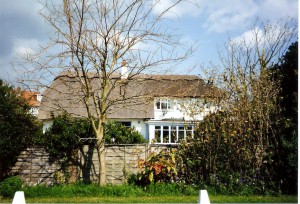As of today (26 August) there are well over 160 objections to this application on the Arun DC website. This illustrates just how unpopular it is, but you still have time to lodge your objection if you wish to do so. You have until the closing date for comments on Thurs 3 September. If you’re thinking about doing so, then please do it for the sake of the village of Ferring. We would like to see well over 200 objections in total. This would give a very clear message to the planners from local people. Details of how to submit your comment are in the post below. Stop Press: Ferring Parish Council also voted overwhelmingly last night to submit a formal objection, as have East Preston Parish Council.
Monthly Archives: August 2015
Apartment block to replace thatched cottage in Ferring?
Ferring residents have been stunned by the news that a developer has applied to replace an attractive thatched cottage in a key location with an apartment block. The cottage has been a landmark feature in south Ferring for three generations
‘There will be very strong resistance to this application’, said David Bettiss, Chairman of Ferring Conservation Group. ‘We have 900 members and we shall be encouraging every one of them to send in objections to Arun District Council. It is an outrage – we knew there was a plan already for four chalet bungalows and we  were having to get used to that idea but ten apartments, in a block that covers the whole site, is really gross overdevelopment and shows no regard for the character of Ferring. This area was built in the 1920s and 1930s in a low density arrangement of bungalows and small houses on large plots. A modern apartment block would be completely out of place’.
were having to get used to that idea but ten apartments, in a block that covers the whole site, is really gross overdevelopment and shows no regard for the character of Ferring. This area was built in the 1920s and 1930s in a low density arrangement of bungalows and small houses on large plots. A modern apartment block would be completely out of place’.
‘Not only that but adding ten lots of car owners would increase the traffic congestion and road safety hazards in a narrow road, at a junction on a blind bend, where it is already difficult to turn safely. We would hope the County Council would condemn it on road safety grounds and that Arun district Council will refuse it as overdevelopment, totally out of character for this area.’
Ed Miller, Secretary of Ferring History Group, added, ‘The cottage is not quite as old as some people think but it was one of the first houses built in the development of the 1920s. Its shape and thatched roof earned it the nickname of ‘The Beehive’ and Beehive Lane – the road connecting the inter-war estate to Sea Lane, was named after it in 1928. The house is a dominant feature in one of the earliest photographs of South Ferring, and has been the centrepiece of many postcards. It’s bad enough that we should lose the cottage but to have it replaced by an apartment block is really too much. Our members will certainly fight this application’.
If you agree that this is an unwelcome and unwanted development in the village, you can object to Arun District Council. Their website is www.arun.gov.uk and the reference number of the application by Globe Estates is FG/116/15 – you can view the plans there. Put in your own words why you don’t want this addition to the landscape of Ferring in the comments section of the application.
Big Butterfly Count and Wildflower Walk
Over 20 members of Ferring Conservation Group met up this week on the Ferring Rife to make their contribution to the national Big Butterfly Count organised by the Butterfly Conservation organisation. This was combined with a Summer flower challenge to see how many different plants could be seen.
Members split up into a number of smaller groups to check out areas protected from the strong westerly breeze on what was otherwise a bright and sunny day. The area of both the south and north lagoons on the East Preston side of the river were surveyed, and a total of 10 different species of butterflies were recorded, with 42 individuals around the south lagoon and 36 in the north. Amongst those seen were Gatekeeper, Meadow Brown, Common Blue, Holly Blue, Speckled Wood, Small White and Red Admiral. The results were duly forwarded to Butterfly Conservation to add to the 25,000 submissions so far, and build up a national picture of butterfly distribution.
The Group then moved on to attempt to find at least 12 summer wild flowers in the area as challenged by walk leader and committee member, Tricia Hall. A number of these plants such as Common Fleabane were proving attractive to butterflies and other insects. Amongst the other plants were the white flowered and pleasant smelling Meadowsweet, Hogweed (not the giant version!), Birds’ Foot Trefoil, Knapweed, Yellow Loosestrife, Bristly Ox Tongue and Yarrow. All of these plants together provide an attractive scene, as well as a valuable habitat for our wildlife in this Site of Nature Conservation Interest (SNCI). Most people managed to complete the challenge and find at least 12 different plants, learning about them in the process.
Just to add to the interest, members also found a Bush Cricket, various Ladybirds, some Day Flying Moths and even a small frog discovered by the grandson of one of the Group members, which was released after a quick photograph.

